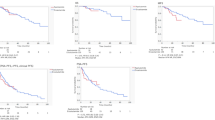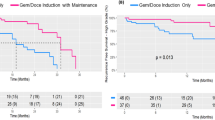Abstract
A total of 20 patients with hormone-refractory prostate carcinoma entered a pilot study of combination chemotherapy based on the EAP (etoposide, Adriamycin and cisplatin) regimen, in which Adriamycin was replaced by pirarubicin, a less cardiotoxic derivative of Adriamycin. The response was assessed by criteria modified from those of the National Prostatic Cancer Project: prostate-specific antigen was employed instead of acid phosphatase. Of 18 evaluable patients, 6 achieved a partial response, 5 had stable disease, and in 7 the disease had progressed during therapy; thus, the overall response rate was 33.3% [95% confidence interval (CI) 11.5–55.1%]. Significant pain alleviation and performance status improvement were obtained in 5 of 12 patients (41.7%; CI 13.8–69.6%) and 3 of 13 patients (23.1%; CI 0.2–46.0%), respectively. Although myelosuppression was moderate to severe, no chemotherapy-related deaths or bacteriologically documented sepsis occurred; nor was there any clinical cardiotoxicity. All the responding patients received maintenance chemotherapy with etoposide thereafter. At present, the median duration of response is 33 weeks (range: 23–91 weeks) and the median survival period for all patients is 42 weeks (range: 27+ −136 weeks), with 12 deaths. In spite of the small number of patients treated, these results suggest that this chemotherapy regimen is active in advanced hormone-refractory prostate carcinoma.
Similar content being viewed by others
References
Achterrath W, Niederle N, Hilgard P (1982) Etoposide — chemistry, preclinical and clinical pharmacology. Cancer Treat Rev 9 [Suppl A]: 3
Agata N, Hirano S, Hara Y, Iguchi H, Shirai M, Tone H, Urakawa N (1991) A comparison of pirarubicin with other anthracyclines on the cardiovascular system. Oyo Yakuri/Pharmacometrics 41: 467
Dantchev D, Paintrand M, Hayat M, Bourut C, Mathé G (1979) Low heart and skin toxicity of a tetrahydropyranyl derivative of Adriamycin (THP-ADM) as observed by electron and light microscopy. J Antibiotics (Tokyo) 32: 1085
Eisenberger M (1990) Chemotherapy for prostate cancer. World J Urol 8: 40
Hindson DA, Knight LL, Ocker JM (1985) Small-cell carcinoma of prostate. Urology 26: 182
Hisamatsu T, Suzuki K, Sakakibara S, Komuro K, Nagasawa M, Takeuchi T, Umezawa H (1985) Antitumor spectrum of a new anthracycline, (2″ R)-4′-O-tetra hydropyranyladriamycin, and effect on the cellular immune response in mice. Jpn J Cancer Res (Gann) 76: 1008
Merrin CE, Beckley S (1979) Treatment of estrogen-resistant stage D carcinoma of prostate withcis-diamminodichloroplatinum. Urology 13: 267
Moertel CG, Kvols LK, O'Connell MJ, Rubin J (1991) Treatment of neuroendocrine carcinomas with combined etoposide and cisplatin. Evidence of major therapeutic activity in the anaplastic variants of these neoplasma. Cancer 68: 227
Murphy GP, Slack NH (1980) Response criteria for the prostate of the USA National Prostatic Cancer Project. Prostate 1: 375
Preusser P, Wilke H, Achterrath W, Fink U, Lenaz L, Heinicke A, Meyer J, Meyer HJ, Buente H (1989) Phase II study with the combination etoposide, doxorubicin, and cisplatin in advanced measurable gastric cancer. J Clin Oncol 7: 1310
Qazi R, Khandekar J (1983) Phase II study of cisplatin for metastatic prostatic carcinoma. An Eastern Cooperative Oncology Group study. Am J Clin Oncol 6: 203
Rapoport BL, Falkson G (1992) Phase II clinical study of pirarubicin in hormone-resistant prostate cancer. Invest New Drugs 10: 119
Schabel FM, Trader MW, Laster WR, Corbett TH, Griswold DP (1979)cis-Diamminedichloroplatinum (II): combination chemotherapy and cross-resistance studies with tumors of mice. Cancer Treat Rep 63: 1459
Schabel FM Jr, Skipper HE, Trader MW, Laster WR Jr, Griswold DP Jr, Corbett TH (1983) Establishment of cross-resistance profiles for new agents. Cancer Treat Rep 42: 905
Seeber S, Osieka R, Schmidt CG, Achterrath W, Crooke ST (1982) In vivo resistance toward anthracyclines, etoposide, and cis-diamminedichloroplatinum (II). Cancer Res 42: 4719
Tetu B, Ro JY, Ayala AG, Johnson DE, Logothetis CJ, Ordonez NG (1987) Small cell carcinoma of the prostate. 1. A clinicopathologic study of 20 cases. Cancer 59: 1803
Tsuruo T, Iida H, Tsukagoshi S, Sakurai Y (1982) 4′-O-tetrahydropyranyladraimycin as a potential new antitumor agent. Cancer Res 42: 1462
Walther PJ, Williams SD, Troner M, Greco FA, Birch R, Einhorn LH, the Southeastern Cancer Study Group (1986) Phase II study of etoposide for carcinoma of the prostate. Cancer Treat Rep 70: 771
Yagoda A, Watson RC, Natale RB, Barzell W, Sogani P, Grabstald H, Whitmore WF (1979) A critical analysis of response criteria in patients with prostatic cancer treated withcis-diamminedichloride platinum II. Cancer 44: 1553
Author information
Authors and Affiliations
Rights and permissions
About this article
Cite this article
Naito, S., Ueda, T., Kotoh, S. et al. Treatment of advanced hormone-refractory prostate carcinoma with a combination of etoposide, pirarubicin and cisplatin. Cancer Chemother. Pharmacol. 35, 225–229 (1995). https://doi.org/10.1007/BF00686552
Received:
Accepted:
Issue Date:
DOI: https://doi.org/10.1007/BF00686552




